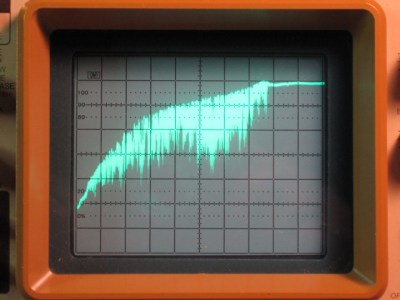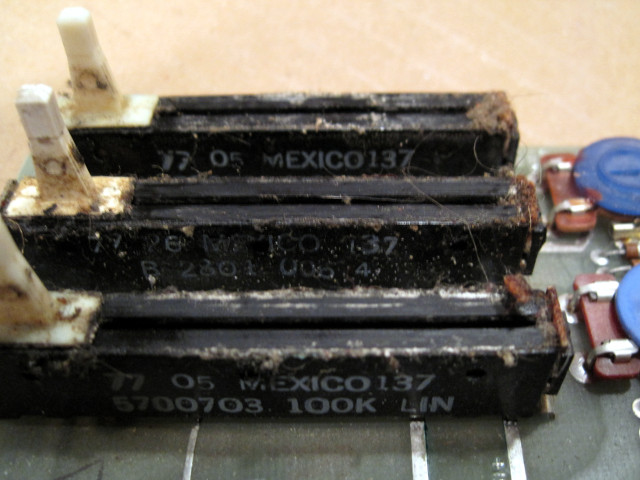As anyone who has ever owned a piece of older equipment that has a potentiometer in it can attest to, these mechanical components do need their regular cleaning ritual. Whether it’s volume knobs on a receiver or faders on a mixer, over time they get crackly, scratchy and generally imprecise due to the oxidation and gunk that tends to gather inside them.

In this blast from the past, [Keith Murray] shows a few ways in which fader-style potentiometers can be cleaned, and how well each cleaning method works by testing the smoothness of the transition over time with an oscilloscope. It’s enlightening to see just how terrible the performance of a grimed-up fader is, and how little a blast of compressed air helped. Contact cleaner works much better, but it’s essential to get all of the loosened bits of gunk out of the fader regardless.
In the end, a soak in isopropyl alcohol (IPA), as well as a full disassembly followed by manual cleaning were the only ones to get the fader performance back to that of a new one. Using contact cleaner followed by blasting the fader out with compressed air seems to be an acceptable trade-off to avoid disassembly, however.
What is your preferred way to clean potentiometers to keep that vintage (audio) gear in peak condition? Let us know in the comments below.
Thanks, [Grant Freese], for the tip!
















If it’s a pot.divider just add a cap on wiper
What a dirty hack.
I love it.
When I used to repair electronics back when potentiometers were popular, we would rub the swab of a q-tip with penetrating oil or WD-40 across the resistive pad
The biggest problem is you need to know what the potentiometer is constructed with in order to find a solvent that won’t kill it. Second problem is you don’t want stuff that leaves a residue because it just collects more garbage.
In the day we used “Pot Lube”, a lubrication / cleaner that left a film of oil.
the fun part is that some of these old sliders dont react well to cone cleaning over the next. be very careful using petroleum cleaning products, as some will take the tracks right off.
I’ve found that more often than not, if a device is at that stage, the resistor printed on the pot is usually partially destroyed and cleaning doesn’t really help that much. I’ve never seen anyone come up with a way to restore a pot, but if any crowd can, this one will…
And if you want an environmentally friendly alternative to WD40, use Ballistol – https://ballistol.de/
Works well for my guitars.
My wife banned me from using Ballistol at all because of the smell.
It’s got an odor to it for sure, but it’s amazing stuff.
If there’s an electrolytic coupling cap or an old paper/foil/wax cap (in old radios and amps) connected to the pot, try replacing the cap. When they go bad they often short and allow DC bias from other parts of the circuit to go through the pot. Nothing makes a pot crackly like a DC flowing through it!
The best thing to use is Caig Deoxit D5. Ham radio folks use it for antique radio refurbishing. This stuff is absolute magic!
My Andromeda has this problem, and this guy recommends Deoxit F5:
https://youtu.be/1PczJWF5WqQ?t=936
Had to read the comments on ths one. My favorite for cleaning is deoxit. Back in the day it was Radio Shack tuner cleaner. I have also had sucess with carb cleaner, brake cleaner, or other fast dry solvents. I suggest using these with caution as you may destroy the resistive element. One other product I like is CRC brand QD electronic cleaner. it’s available in most U.S. automotive stores and is fairly cheap. The best results are if you can disassemble the part and clean the element. If not blow the part out with air then solvent followed by air. Just my opine so use with caution. Your results may vary.
Another vote for Deoxit in this situation. With me, it’s all buggy rotary encoders, but same-same.
I haven’t tried pulling them off the board, soaking, and replacing, though. So much more work…
Yup, Deoxit all the way for pots. It cleans, deoxidizes, and lubricates. If you just clean the pot it will become scratchy again soon.
Be careful with electronics cleaners from the auto parts store. Make sure it says safe on plastics. I found the safe on plastics cleaner at Harbor Freight.
Don’t use contact cleaner on pots, unless they are wire-wound pots. Contact cleaner is for contacts–switches, relays, and connectors.
Contact cleaner *might* solve a carbon pot issue over the short run (it WILL indeed flush out crud), but it is just as likely to ruin the pot. I’ve also had pots, “restored” with contact cleaner, become noisy and intermittent again after a short while.
A far better material to use is Faderlube, incidentally, also a Caig product.
https://www.amazon.com/Hosa-F5S-H6-DeoxIT-FaderLube-Spray/dp/B00006LVF1
We need to come up with a repair that can coat the strip with new carbon resistance. I’ve dissembled and bent the fingers on the slider to a new track to fix a few.
One fix I use after blowing out is to polish the slide contact strip with a thin fiberglass rod through the slot which fixes the noise completely on some brands of slide pots. The metal strip is more often than not the noise source than the abrading carbon track. To solvent and blast out the dirt also gets what is left of the lube and some stiff sliders fail when pushy users break the handle off. Use a little silicone lube after cleaning.
My Arp Odyssey coarse and fine tuning pots (4) were carbon crap, as coarse as tuning can get.
I replaced them with two 10-turn pots for far better tuning control of the 2 VCO’s. Slide pots are quick but not accurate unless long enough.
Maybe some kind of rub-on dry transfer sheet with the transferable images being carbon tracks of known size and resistance, which you’d match with the track your device needs.
At many PCB manufacturers you can order printed resistors on your design. So if the original pot is unsalvagable you could replace the pcb part on the bottom of the pot with a new one. Of course the quality might be different.
Yep! Regular cleaning of this is quite important.
I have a Saitek X52 flight stick with a bad potentiometer in it. Using Deoxit got it working properly again but it returned to being bad shortly; I wonder if a lack of lubrication was the problem. If so, I might have damaged the potentiometer by running it dry.
I wonder how hard it would be to make a Hall Effect replacement.
Not sure if it has been mentioned above but another way of getting more life out of old pots is tweaking the wiper so it travels along a new path
I have a couple of methods for cleaning pots. First is a light blowing of compressed air, then a squirt of alcohol, then I use a product called LPS. I rarely use deoxit because it does not remove and dust or debris. Additionally it will cause the pot to feel to loose. Lastly for faders or sliders, I’ll soak and wash with dish soap, then a squirt of alcohol, then use compressed air.